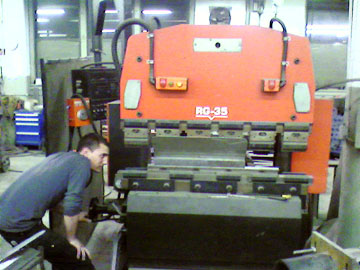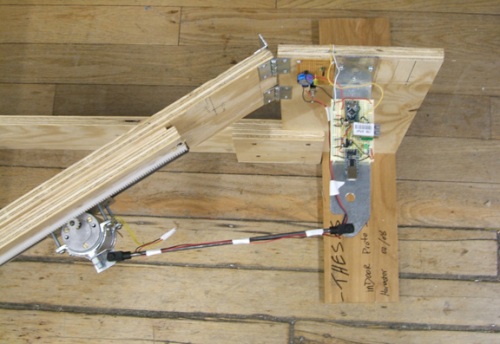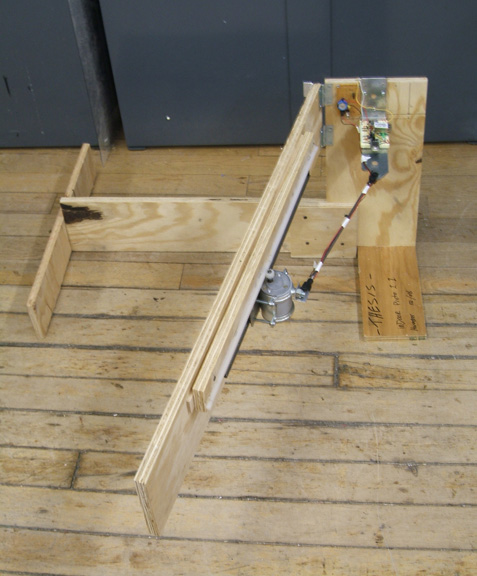small generator – big output


generator size

- generator prototype example
Filed under: Uncategorized | Leave a Comment
It has been too long since my last post, but many exciting things have happened since – most of which is in collaboration with GRouND LAB.
To follow-up on the topic of energy conversion and storage from human-powered kinetic sources I have rebuilt a new prototype for the inDoor Energy Harvester that has proven thus far to surpass our expectations and can now easily be customizable for revolving as well as traditional hinged doors.
Each generator is about 3″x3″x3″ and consist of a bipolar motor/generator attached to a planetary 10:1 gearbox. It outputs on average 25volts at just above 1/4amp and can reach 100volts at 1/2amp.
This means that on the low-end one small generator outputs 5watts and can reach 50watts.
Thus, if we install 4 generators per leaf of a revolving door that turns for about 8 hours per day ->
one door can on average produce 20watts per leaf, 80 watts per door over 8 hours = 640watt hrs
This is enough to run a 60 watt light bulb for about 11 hrs (we use the light bulb purely as an indicator rather than a practical application).
With the energy harvesting modules attached to the existing doors, we would simply need to release some of the tension on the doors braking mechanism for the door to feel exactly the same, thereby channeling some of the kinetic energy that would have been wasted as friction and heat on a brake to usable electricity.
In addition we have developed a monitoring and visualization system of the doors for the building managers, the people walking through, as well as ourselves to quickly understand what is being produced over a given time period. We have a system in place to monitor, store and graph the data in real-time from the web as well as from a mobile phone.
We propose, to begin with, having the energy generated from the doors power the energy monitoring and visualization systems to create a zero carbon system as a proof of concept until we have a good idea of what is being created and stored over time. After a month or so of testing we would more accurately be able to suggest effective applications for the building.
I am confident that with a little more time and incentive we can increase the efficiency and output of our current generators and provide a working prototype relatively quickly.
I will be posting a 3d fly through rendering soon to show in detail how we propose attaching these modules to existing doors without removing or changing the current doors architecture.
till then…
Filed under: Phys Comp, physical computing, sustainable energy, Uncategorized | 2 Comments
prototyping and fabricating
I have been doing prototyping for a sustainable energy start up in Brooklyn, SMIT – sustainable minded interactive technology, for the past two years.
I have been working mostly on data-logging and visualization for their solar/wind hybrid system from a sensor network that graphs both energy stored over time with wind speed, temperature and light intensity. These values are also stored locally on an SD Card as a comma separated file along with a time/date stamp from an on board real time clock module.
I have also started my own business, RZD – Raphael Zollinger Designs LLC, which has worked in conjunction with Ohad Folman on Plug-gage, an energy generating suit-case. I prototyped a system that transfers the kinetic energy from the wheels as its being moved around the airport to a stepper motor generator that stores the current in a battery. It has a visual multimeter, 2 usb outputs and an inverter with one plug for ac. The front also has a pouch to roll out a flexible solar cell for additional input.
coming up, I will be prototyping a system for, weCycle NYC, an event based recycling program, to data-log their bins use via an xbee mesh network to display their use on the web. All the data-loggers will be solar powered.
Lastly, promising talks with UNICEF to prototype a hand held data-logger for doctors in Malawi to input patient information. This with GRND Lab, a design collaborative I am a part of.
more updates soon and details of these projects.
and a new website for my LLC.
Filed under: Uncategorized | 2 Comments
indoor energy harvester update
The inDOOR Harvester was installed on a door leading from the stair well to the main lobby of the ITP program on the fourth floor of the Tisch Building at NYU in May and has been running since. I had to change how often it uploaded to the dataBase as my php script would crash when faced with pulling over a certain amount of data at a time. Have yet to figure out this problem and why. These sort of things can only come up with months of such invaluable user testing. I am currently working on something to give users some sort of immediate physical feedback when the capacitor is close to charged – some interesting and descriptive use of the electricity produced. Please stop by 721 Broadway, 4fl to take a look is in the area while its up .
or go to the live monitoring site: http://www.indoorharvesting.com
Filed under: Uncategorized | Leave a Comment
presentation
here is a link to a 15 min quicktime video from the presentation i gave to the Interactive Telecommunication Program(ITP) at NYU. Everything you wanted to know about energy harvesting from the things that people do everyday and my efforts to prototype this system and how it works. – it may take a little while to load and play –
Filed under: Uncategorized | Leave a Comment
The inDOOR Energy Harvetser debuted to the public at the ITP spring show at NYU during this 2 day event. It worked well to some great user responses and interest. All of its use was data-logged and graphed on the web site. People got to see their use of the door light up the exit sign.



Filed under: thesis | Leave a Comment
prototype 2.0: a door generator
I built a door, frame and wall today and attached the new prototype to it in its stainless housing for user testing. It now powers its own circuitry as well as a low power exit sign i made.
Its web presence/monitor now lives here – indoorharvesting.com
Here are a few images – more to come soon.


minus housing

and some video soon.
Filed under: thesis | Leave a Comment
A housing in the works
I spent the evening with a good friend of mine, Matthew Flego an industrial designer, at his metal fabrication shop, Ferra Design in the Brooklyn Navy Yards. He and I plotted out the design for a 12 gauge stainless steal housing for the inDOOR Harvester module in Solid Works, a 3d object CAD application.

The file was exported to a water jet cutter, an amazing automated machine that uses water and ground garnet as an abrasive to cut through any material up to the 1000th of an inch. It perfectly cut the shapes with their , tabs, holes and score-lines for the brake to bend.
Next, I hand tapped all of the holes with 10/32 thread and then took it to the brake to form the sheets into the actual housing. Using up to 20 tons of pressure, the steal became paper like as it bent and curved under the jaws of the brake.

the parts were then tig welded together, ground and surface treated.


then attaching the slide, generator and gear rack to match the prototype.

more images to post soon as it nears completion…
Filed under: sustainable, thesis, Uncategorized | Leave a Comment
The InDOOR Harvester Dashboard
A glimpse at the revised version of the online dashboard monitor for the energy harvesting module.
It been a big javascript learning curve this past week, but well worth it.
Many more features and improvement still to come, as well as further data integration.
check it out – let me know what you think.
Filed under: arduino, network objects, Phys Comp, physical computing, sustainable, thesis | Leave a Comment
Tags: dashbaord monitor, energy harvesting
inDOOR Harvester prototype 1.1
I’ve spent the last two week testing and researching linear motion guides, blocks and rails, to carry the gear motor along the door and across a rack. Due to exploding bearings and bent rails, McMaster-Carr has both saved my thesis and made a nice chunk of change. A far more effective and elegant system from the last version: a steel bracket on the wall side with a rotating clevis end holding a 1/4″ rod connects to the motor mount with another clevis rod end piece. I’ve also found a type 304 stainless steel side-mount ball bearing guide block and rail that’s able to with stand the pressure the arm exerts as it pushes/pulls the motor attached to the guide block as the door opens and closes (load capacity of 197lds). It also keeps constant pressure on the pinion gear against the rack. The gear has also been reduced to 1/2″, thus providing slightly more rotations within the motor/generator -> slightly more power out, thereby slightly more resistance to move it.

The circuitry seen on the left if a simple AC input from generator to a bridge rectifier that outputs DC to a 1F 5.5v storage capacitor. I also have a switch and LED to drain the cap for testing. On the breadboard is the testing and data logging circuit with an Arduino stamp connected to the capacitor. It sends out an HTTP requests through a Lantronix Ethernet port that calls a php script to insert the values into a mySQL database. On the back of the door I have installed a switch that the mico-controller uses to count the number of times the door opens.

next: looking into a light weight housing for the module for easy install and easy to look at.
Filed under: arduino, physical computing, sustainable, sustainable energy, thesis | Leave a Comment



